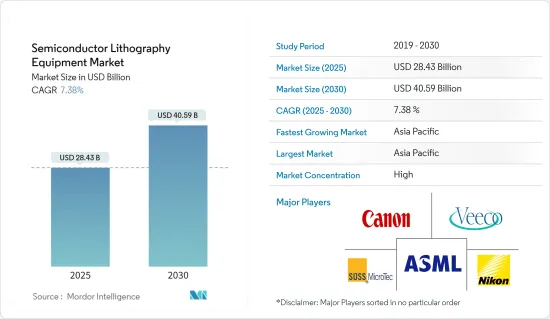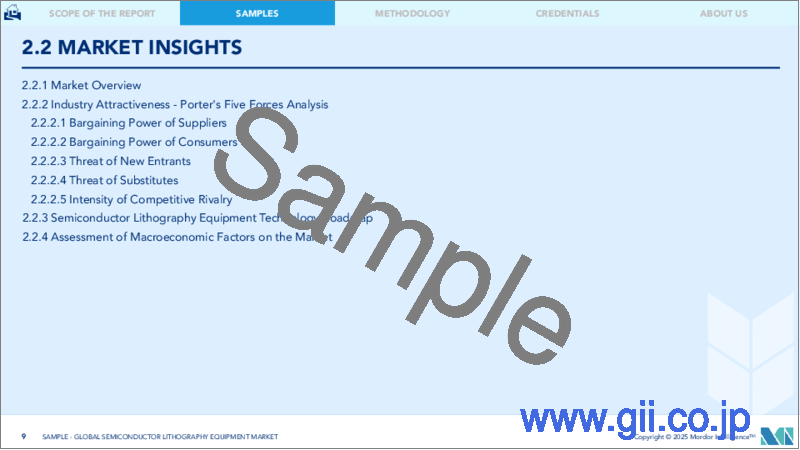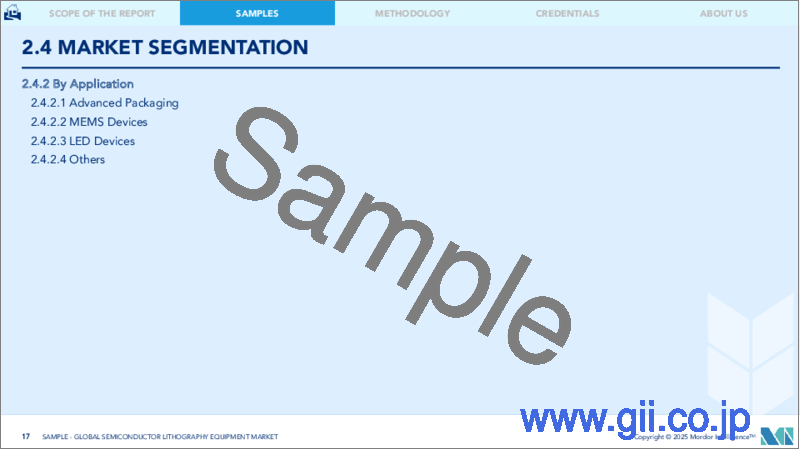|
|
市場調査レポート
商品コード
1690752
半導体リソグラフィ装置:市場シェア分析、産業動向・統計、成長予測(2025~2030年)Semiconductor Lithography Equipment - Market Share Analysis, Industry Trends & Statistics, Growth Forecasts (2025 - 2030) |
||||||
カスタマイズ可能
適宜更新あり
|
|||||||
| 半導体リソグラフィ装置:市場シェア分析、産業動向・統計、成長予測(2025~2030年) |
|
出版日: 2025年03月18日
発行: Mordor Intelligence
ページ情報: 英文 123 Pages
納期: 2~3営業日
|
全表示
- 概要
- 目次
半導体リソグラフィ装置市場規模は2025年に284億3,000万米ドル、2030年には405億9,000万米ドルに達すると予測、予測期間(2025~2030年)のCAGRは7.38%。

主要ハイライト
- 半導体リソグラフィ装置市場は、民生用電子機器、自動車など、ほぼすべてのセグメントで広く使用されている半導体デバイスの製造が拡大していることから、成長が見込まれています。スマートデバイスの採用は増加しており、5Gの接続と採用が世界中に広がるにつれて成長すると予想されます。GSMAによると、5Gモバイルブロードバンド接続は2025年までに11億に達し、5Gの普及は2025年までに世界人口の34%をカバーすると予想されています。
- 半導体のFAB(製造)コストの50%以上は装置とツールによるものです。半導体製造プロセスを前進させる装置のひとつがリソグラフィーです。半導体製造には、リソグラフィ装置によって左右される側面がいくつかあります。技術的な観点から見ると、歩留まりと欠陥がそのような2つの例です。半導体製造が、どのタイプのリソグラフィ技術を導入するかに多くの焦点を当てているのは、これが主要理由です。
- 半導体製品の複雑化に伴い、欠陥のタイプも複雑化しています。しかし、リソグラフィ装置はこの複雑なプロセスに対応するものです。半導体メーカーが次世代先端技術ノードに注力する中、エラーのないリソグラフィ装置の重要性はさらに高まっています。
- さらに、製造業は最近、5Gの出現とIoT接続デバイスの出現によって著しい成長を遂げており、ワイヤレス制御などの様々なインダストリー4.0アプリケーションに必要な接続が容易になると予想されています。これは特にモバイルツール、機械、ロボットに不可欠であり、予測期間中の市場成長を助けることができます。
- 複数の産業企業が、幅広いアプリケーションに対応する新しいリソグラフィシステムの提供に注力しています。例えば、2022年3月、Nikon Corporationは、ハイエンドモニター、大型テレビ、スマートデバイスなどの付加価値の高いプレミアムディスプレイ用の様々な高精細パネルの生産をサポートする新しいGen 8プレートFPDリソグラフィシステムを発売すると発表しました。
- 半導体産業は最も複雑な産業のひとつであり、その製造・検査プロセスは500以上にも及びます。そのため、製造プロセスの複雑さにもよりますが、半導体ウエハーの完全な製造・検査だけでも約1400ものプロセスがあります。このような複雑なプロセスは、市場の成長にとって特筆すべきハードルとなっています。
半導体リソグラフィ装置市場動向
深紫外リソグラフィ(DUV)が主要市場シェアを占める
- 深紫外リソグラフィ(DUV)は、マスク上のパターンを4倍または5倍の光学系を通してウエハー表面に投影する光投影リソグラフィ技術です。このタイプのリソグラフィーに使用される波長は248nmまたは193nmです。このリソグラフィは、DUVツールの典型的なウエハーレベル露光フィールドサイズである22mm×22mm以下のディスクリート部品の大面積マスターに最適な高速リソグラフィ技術です。
- DUVリソグラフィは、次世代リソグラフィ技術の代表的なもの一つです。この技術はコスト効率が高く、解像力が向上しています。DUVリソグラフィの採用は、主に微細化の動向によって推進されています。リソグラフィは、半導体ウエハー上に集積回路(IC)を特徴づける複雑なパターンを印刷するために使用されます。
- DUVリソグラフィーを使えば、電力需要の少ない軽量電子チップを簡単に実現できます。このプラットフォームは、電力分解能が向上し、コスト効率に優れています。これらの構造が一体となってICを形成し、チップとして知られています。半導体産業がより効率的なマイクロチップを追求することは、チップメーカーがより多くの構造をチップ上に研究する必要があることを意味し、チップをより高速かつ効率的にするとともに、製造コストを削減します。このことは、予測期間中の市場の成長を押し上げると予想されます。
- ASMLによると、EUVへの移行はDUVの需要をさらに押し上げる可能性があります。チップメーカーは、チップ製造の初期段階でEUVを導入し、トランジスタ、最小ビア(ソース、ゲート、ドレインを複雑な相互接続層に接続するコンタクト)、場合によっては接続層といった微細構造を適用します。
- WSTSによると、2024年1月の欧州半導体売上高は44億2,000万米ドルに達し、2023年1月の44億8,000万米ドルから若干減少しました。2024年1月の世界半導体売上高は、市場全体を考慮すると476億3,000万米ドルに達します。
- このような市場の開拓は、半導体生産増強に向けた政府の取り組みとともに、予測期間中の市場成長を牽引するものと期待されます。
大きなシェアを占める米国
- 米国は強固な半導体研究開発能力を誇り、半導体製造能力の拡大に向けた大規模な投資、先端技術の急速な採用が行われています。
- さらに、米国は半導体需要の増加を目の当たりにしています。例えば、2021年9月の世界半導体貿易統計(WSTS)によると、2021年の半導体産業売上高は5,270億米ドルと大幅に増加し、主に2020年市場全体の力強い需要の伸びにより、2020年の予測から上方修正されました。2022年、WSTSは世界売上高を5,730億米ドルと予測しています。
- さらに、2022年4月、Semiconductor Equipment and Materials Internationalによると、北米の半導体装置への支出は2020年の65億3,000万米ドルに対し、2021年は76億1,000万米ドルに達しました。
- また、半導体産業団体は、米国半導体産業はチップ設計のリーダーであると述べています。米国のファブレス企業は世界のファブレス企業の売上高の約60%を占めており、その手配を行う最大手のIDMの一部も米国企業です。
- 米国半導体産業の状況によると、半導体チップ上で動作するコネクテッドデバイス(i.o.T.:モノのインターネット)は2019年に226億米ドルを記録し、2025年には750億米ドルに達すると予想されています。半導体はまた、医療を強化し、建築コストを削減し、食糧供給を強化し、科学の進歩を可能にする3Dプリンティング、機械学習、人工知能(AI)などのイノベーションの基盤でもあります。この地域の旺盛な半導体需要は、予測期間中、半導体リソグラフィ装置の採用を後押しすると考えられます。
- さらに、2022年9月、バイデン政権は、米国が国家安全保障に不可欠な世界の最先端チップの生産量ゼロ、消費量25%であることから、中国依存に対抗するため、国内半導体産業の育成に500億米ドルを投資すると発表しました。ジョー・バイデン大統領は2022年8月、中国に対する米国の競合強化の一環として、国内のハイテク製造業を後押しする2,800億米ドルのCHIPS法案に署名しました。この地域の半導体セクタへのこのような力強い投資は、研究市場の成長に有利な機会を提供すると考えられます。
半導体リソグラフィ装置産業概要
市場はASML、Veeco、Nikonなど少数のベンダーに集中しています。半導体製造用の主要装置は、基本的に米国企業と日本企業が独占しています。統合の進展と技術進歩、地政学的なシナリオにより、調査対象市場は変動しています。また、垂直統合の進展に伴い、収益に見合う投資能力を考慮すると、市場競争の激化は今後も続くと予想されます。
- 2022年9月-Canon Inc.が半導体露光装置向けソリューションプラットフォーム「Lithography Plus1」を発表。Canonの半導体露光装置サポートにおける50年以上の経験と膨大なデータをシステムに取り込み、サポート効率を最大化し、最適なシステムプロセスを提案・実現します。
- 2022年6月-SamsungとASMLは、High-NA(高開口数)EUVリソグラフィ装置の開発で協業することで合意。次世代High-NA EUVリソグラフィ装置は、旧来のEUVリソグラフィ装置と比較して、より微細な回路を形成することができます。
その他の特典
- エクセル形式の市場予測(ME)シート
- 3ヶ月間のアナリストサポート
目次
第1章 イントロダクション
- 調査の前提条件と市場定義
- 調査範囲
第2章 調査手法
第3章 エグゼクティブサマリー
第4章 市場洞察
- 市場概要
- 産業の魅力-ポーターのファイブフォース分析
- 供給企業の交渉力
- 買い手の交渉力
- 新規参入業者の脅威
- 代替品の脅威
- 競争企業間の敵対関係
- 半導体リソグラフィ装置の技術ロードマップ
- マクロ経済動向が市場に与える影響
第5章 市場力学
- 市場の促進要因
- 電気自動車や先進モバイル機器による小型化・高機能化要求の高まり
- 新しいリソグラフィ装置を提供する専門装置ベンダーによる技術革新の進展
- 市場抑制要因
- 製造プロセスにおけるパターンの複雑性に関する課題
第6章 市場セグメンテーション
- タイプ
- 深紫外リソグラフィ(DUV)
- 極端紫外線リソグラフィ(EUV)
- アプリケーション
- 先進包装
- MEMSデバイス
- LEDデバイス
- 地域
- 北米
- 欧州
- アジア
- オーストラリアとニュージーランド
- ラテンアメリカ
- 中東・アフリカ
第7章 競合情勢
- 企業プロファイル
- Canon Inc.
- Nikon Corporation
- ASML Holding NV
- Veeco Instruments Inc.
- SUSS MicroTec SE
- Shanghai Micro Electronics Equipment(Group)Co. Ltd
- EV Group(EVG)
- JEOL Ltd
- Onto Innovation(Rudolph Technologies Inc.)
- Neutronix Quintel Inc.(NXQ)
- ベンダー市場シェア分析
第8章 投資分析
第9章 市場の将来
The Semiconductor Lithography Equipment Market size is estimated at USD 28.43 billion in 2025, and is expected to reach USD 40.59 billion by 2030, at a CAGR of 7.38% during the forecast period (2025-2030).

Key Highlights
- The semiconductor lithography equipment market is expected to grow with the growing manufacturing of semiconductor devices that are widely used in nearly all sectors including consumer electronics, automotive, and many others. Smart device adoption is increasing and is expected to grow as 5G connections and adoption spread over the globe. As per GSMA, 5G mobile broadband connections are expected to reach 1,100 million by 2025, with the 5G rollout expected to cover 34 percent of the world's population by 2025.
- More than 50 percent of the semiconductor FAB (fabrication) cost is due to equipment and tools. One piece of equipment that drives the semiconductor fabrication process forward is lithography. There are several aspects of semiconductor fabrication that has driven by lithography equipment. Yield and defect are two such examples from the technical point of view. It is the primary reason why semiconductor fabrication focuses a lot on which type of lithography technology to deploy.
- With the rising complexity in semiconductor products, the types of defects are also getting complex. However, lithography equipment is supposed to handle the complex process. With semiconductor manufacturers focusing on next-gen advanced technology nodes, the importance of error-free lithography equipment is significantly increasing further.
- Moreover, manufacturing businesses are are lately growing at a signficant rate with the advent of 5G and emergence of IoT connected devices, which is anticipated to facilitate the connection required for various Industry 4.0 applications, such as wireless control. This is especially essential for mobile tools, machines, and robots that can aid market growth during the forecast period.
- Several industry players are focusing on offering new lithography systems to serve a wide range of applications. For instance, in March 2022, Nikon Corporation announced to launch new Gen 8 plate FPD lithography system to support the production of various high-definition panels for value-added premium displays, such as high-end monitors, large TVs, and smart devices.
- The semiconductor industry is considered as one of the most complex industries, not only owing to the presence of more than 500 processing steps involved in the manufacturing and inspection and various products but also due to the harsh environment it goes through, e.g., the volatile electronic market and the unpredictable demand. Therefore, depending on the intricacy of the manufacturing process, there are about 1,400 process steps in the complete manufacturing and inspection of semiconductor wafers alone. Such a complex process poses a notable hurdle to the market's growth.
Semiconductor Lithography Equipment Market Trends
Deep Ultraviolet Lithography (DUV) to Hold Major Market Share
- Deep UV lithography (DUV) is an optical projection lithography technique where the pattern on the mask is projected to the wafer surface through a 4X or 5X optical system. The wavelengths used for this type of lithography are 248 nm or 193 nm. This lithography is a high-speed lithographic technology ideal for large-area masters of discrete components that are not bigger than 22 mm x 22 mm, the typical wafer-level exposure field size of a DUV tool.
- The DUV lithography type is one of the leading lithography technologies of the next generation. The technology is cost-effective and has increased resolving power. The adoption of DUV lithography is driven primarily by the miniaturization trend. Lithography is used for printing complex patterns that characterize integrated circuits (ICs) on semiconductor wafers.
- Using DUV lithography, lightweight electronic chips with lower power demands are easy to achieve. The platform features enhanced power resolution and is cost-effective. These structures together form an IC, which is known as a chip. The semiconductor industry's search for even more efficient microchips means chipmakers have to study more structures onto a chip, making the chip faster and more efficient while also reducing production costs. This is expected to boost the market's growth over the forecast period.
- According to ASML, a transition to EUV may only boost demand for DUV. Chip manufacturers deploy EUV in the early stages of chip fabrication to apply the minor structures: transistors, smallest vias (the contacts that connect the source, gate, and drain to the complex interconnect layers), and possibly the connecting layer.
- According to WSTS, Semiconductor sales in Europe reached 4.42 billion USD in January 2024, a slight decrease from the 4.48 billion USD reported in January 2023. Global semiconductor sales hit 47.63 billion U.S. dollars in January 2024 when considering the overall market.
- Such developments by the major vendors, along with the initiatives taken by the government to boost their semiconductor production, are expected to drive market growth over the forecast period.
United States to Witness Significant Share
- The United States boasts robust semiconductor R&D capabilities, significant investments catering to the expansion of semiconductor manufacturing capabilities, and rapid adoption of advanced technologies.
- Further, the United States is witnessing an increasing demand for semiconductors. For instance, in September 2021, according to the world semiconductor trade statistics (WSTS), semiconductor industry sales increased significantly to USD 527 billion in 2021, an upward revision from the 2020 forecast for 2021 due mainly to the strong demand growth in the overall market 2020. In 2022, WSTS forecasted global sales totaled to USD 573 billion.
- Additionally, in April 2022, according to Semiconductor Equipment and Materials International, North America's spending on semiconductor equipment reached USD 7.61 billion in 2021 compared to 2020, which was USD 6.53 billion.
- Also, the semiconductor industry association stated that the US semiconductor industry is a leader in chip design. The United States fabless firms account for roughly 60 percent of all global fabless firm sales, and some of the largest IDMs, which make their arrangement, are also US firms.
- According to the state of the US semiconductors industry, the connected devices that run on semiconductor chips (i.e., the Internet of Things (IoT)) registered USD 22.6 billion in 2019 and are expected to reach USD 75 billion by 2025. Semiconductors are also fundamental to innovations, such as 3D printing, machine learning, and artificial intelligence (AI) that enhance healthcare, reduce building costs, strengthen food supply, and enable advancements in science. The region's robust semiconductor demand is likely to boost the adoption of semiconductor lithography equipment during the forecast period.
- Additionally, in September 2022, the Biden administration announced that it would invest USD 50 billion in building up the domestic semiconductor industry to counter dependency on China, as the US produces zero and consumes 25 percent of the world's leading-edge chips vital for its national security. President Joe Biden signed a USD 280 billion CHIPS bill in August 2022 to boost domestic high-tech manufacturing, part of his administration's push to boost US competitiveness over China. Such robust investments in the semiconductor sector in the region would offer lucrative opportunities for the growth of the studied market.
Semiconductor Lithography Equipment Industry Overview
The market is concentrated due to a few vendors such as ASML, Veeco, and Nikon occupying the majority market share. The key equipment for semiconductor manufacturing is basically monopolized by American and Japanese companies. With growing consolidation and technological advancement, and geopolitical scenarios, the studied market is witnessing fluctuation. In addition, with increasing vertical integration, the intensity of competition in the studied market is expected to continue to rise, considering their ability to invest, which results from their revenues.
- September 2022 - Canon Inc. launched the "Lithography Plus1" solution platform for semiconductor lithography systems. Canon's more than 50 years of experience in semiconductor lithography system support and the company's vast wealth of data are incorporated into the system to maximize support efficiency and propose and implement optimized system processes.
- June 2022 - Samsung and ASML have agreed to collaborate on developing High-NA (high numerical aperture) EUV Lithography equipment, which will be available next year. Compared to older EUV Lithography equipment, the next-generation High-NA EUV Lithography equipment can engrave finer circuits.
Additional Benefits:
- The market estimate (ME) sheet in Excel format
- 3 months of analyst support
TABLE OF CONTENTS
1 INTRODUCTION
- 1.1 Study Assumptions and Market Definition
- 1.2 Scope of the Study
2 RESEARCH METHODOLOGY
3 EXECUTIVE SUMMARY
4 MARKET INSIGHTS
- 4.1 Market Overview
- 4.2 Industry Attractiveness - Porter's Five Forces Analysis
- 4.2.1 Bargaining Power of Suppliers
- 4.2.2 Bargaining Power of Buyers
- 4.2.3 Threat of New Entrants
- 4.2.4 Threat of Substitute Products
- 4.2.5 Intensity of Competitive Rivalry
- 4.3 Semiconductor Lithography Equipment Technology Roadmap
- 4.4 The impact of macroeconomic trends on the Market
5 MARKET DYNAMICS
- 5.1 Market Drivers
- 5.1.1 Increasing Demand for Miniaturization and Extra Functionality by Electric Vehicles and Advanced Mobile Devices
- 5.1.2 Growing Innovation by Specialist Equipment Vendors offering Brand New Lithography Tools
- 5.2 Market Restraints
- 5.2.1 Challenges Regarding Complexity of Pattern in Manufacturing Process
6 MARKET SEGMENTATION
- 6.1 Type
- 6.1.1 Deep Ultraviolet Lithography (DUV)
- 6.1.2 Extreme Ultraviolet Lithography (EUV)
- 6.2 Application
- 6.2.1 Advanced Packaging
- 6.2.2 MEMS Devices
- 6.2.3 LED Devices
- 6.3 Geography
- 6.3.1 North America
- 6.3.2 Europe
- 6.3.3 Asia
- 6.3.4 Australia and New Zealand
- 6.3.5 Latin America
- 6.3.6 Middle East and Africa
7 COMPETITIVE LANDSCAPE
- 7.1 Company Profiles
- 7.1.1 Canon Inc.
- 7.1.2 Nikon Corporation
- 7.1.3 ASML Holding NV
- 7.1.4 Veeco Instruments Inc.
- 7.1.5 SUSS MicroTec SE
- 7.1.6 Shanghai Micro Electronics Equipment (Group) Co. Ltd
- 7.1.7 EV Group (EVG)
- 7.1.8 JEOL Ltd
- 7.1.9 Onto Innovation (Rudolph Technologies Inc.)
- 7.1.10 Neutronix Quintel Inc. (NXQ)
- 7.2 Vendor Market Share Analysis





